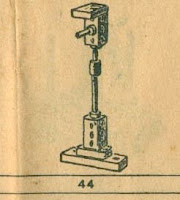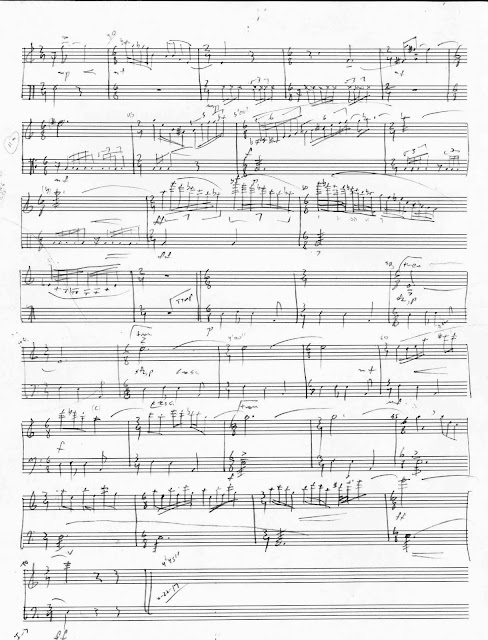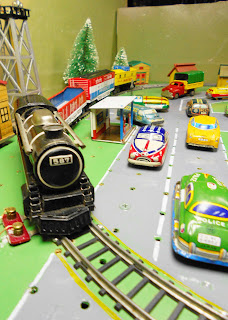 |
The new Straco set on the display layout. There's something
missing for sure. |
Read all the installments of the Straco Express layout project here.
Last fall I wrote about a Straco Express variation I found (see:
Straco and the Mystery Train 2). There appeared to be another version of the Straco Express with differently lithographed cars -- or where there?
A set became available on eBay, and since it was in my price range (less that $30). Many times eBay listings are wildly inaccurate -- it's not from an intention to defraud, but simply one of ignorance. I've seen mismatched pieces described as a "set" before, and I wasn't sure I wasn't seeing it again.
The train consisted of a Pennsylvania steam locomotive, a Michigan Central/NYC gondola car, a State of Maine boxcar, and a Union Pacific caboose. What I didn't see was a coal tender behind the loco (and
I have thing about that). Was this set indeed complete?
Consultation with my colleagues in the
Sekai Toy Train Group (specializing in vintage Japanese toy and model train sets) confirmed that it was complete. This steam engine never had a tender. Like the original Straco Express, it had a locomotive and three cars.
 |
| The original Straco Express (l) and the steam engine version (r). |
When the set arrived, I did some basic lubrication and tried it out on the layout. It ran fine, but the engine had a tendency to jump the track after doing three quarters of the loop. I'm not sure why -- but that's a problem to solve on another day.
In examining and comparing the two sets, though, I made some surprising discoveries.
I removed the locomotive's shell to examine the works and got my first surprise. This loco could actually puff smoke!
 |
The heating element is the grey plastic cylinder mounted in the shell.
The clear plastic bellow is attached to it. |
As you can see in the photo above, there was a small heating element that was attached to a clear plastic bellow.
 |
The L-shaped arm in the front of the chassis moves back and forth to
pump the bellow. |
The electric motor powered the rear wheels via a drive shaft. A second larger eccentric gear pushed an arm back and forth. This arm pumped the bellow, causing the engine to puff smoke. It's an ingenious mechanism, especially for such an inexpensive toy.
 |
| Original Straco Express diesel (l) and later steam engine (r). |
With the exception of the smoke mechanism, the drives for the diesel and steam locos are pretty much the same. I think they both have about the same draw, which explains why both sets have the same number of cars (and therefore, why there's no tender).
Still, it's a well-made piece. Note that the ladders have individual rungs, and how solid the front of the loco is. Also note how many individual pieces its composed of. All of those are attached with tabs bent by hand.
Despite the Pennsylvania RR designation, I suspect the loco was based on a Japanese prototype. Still, it's an appealing little engine. And as you can see, makes a nice addition to the Straco display layout.
So what about the cars that came with the set? They yielded another insight, as I'll explain in the second part of this post.
Layout construction:
- Pegboard: $4.95
- Flathead Screws: $0.40
- Molding: $2.49
- SilClear: borrowed from a friend
- Green Paint: leftover from another project
- Wood Screws: $3.60
- Felt Pads: $1.99
Power Pack: $5.90
Small Houses: $3.00
Testor's Gray Paint for road: $1.29
Bandai Areo Station: $8.99
2 tinplate signs: $1.00
4 tinplate signs (with train) $5.99
Cragstan HO Light Tower $20.49
4 nesting houses $4.99
Tinplate gas station: $5.00
Vehicles:
- Two Japanese toy cars: $2.00
- A.W. Livestock truck: $4.99
- Taxi: $2.99
- Ambulance: $2.99
- Two Japanese patriotic cars: $6.99
- Haji three-wheel sedan $3.00
- Haji three-wheel tanker $5.00
- 1950's sedan $2.99
- LineMar Police Car $9.00
- LineMar Pepco Truck $8.50
- LineMar Bond Bread Van $8.00
- LineMar Fire Engine $4.95
- LineMar Dump Truck $12.99
- LineMar GE Courier Car $10.98
- LineMar County School Bus $9.99
- Nomura Red Sedan $5.00
- Nomura Police Car $2.52
- Nomura lumber truck $3.48
- 6 Nomura vehicles $16.99
- Orange Sedan $10.99
- King Sedan $9.95
- Indian Head logo sedan $4.99
- Indian Head (?) convertible $18.00
- Yellow/red Express truck $9.99
- Red limousine FREE
Total Project Cost: $238.35



















































